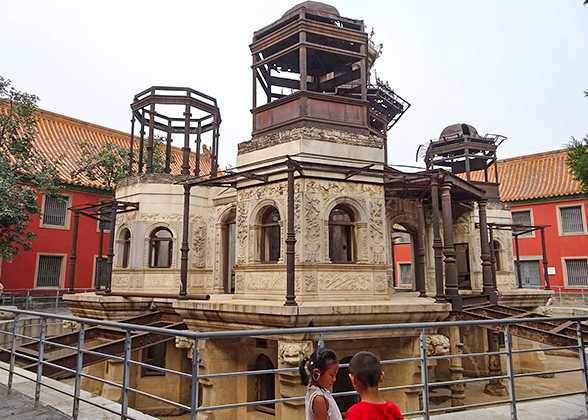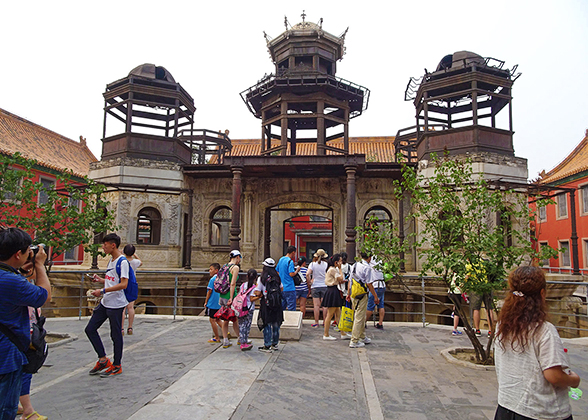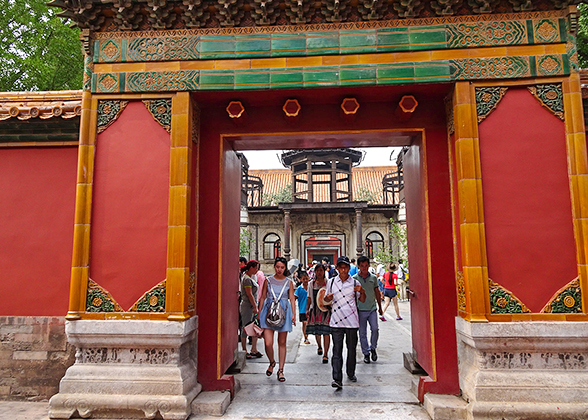The Palace of Prolonging Happiness (Yanxigong) is situated at the southeast inner court of the
Forbidden City, south to the Palace of Eternal Harmony (Yonghegong) and east to the Palace of Great Benevolence (Jingrengong). Yanxigong was built in 1420, in
Ming Dynasty as one of the Six Eastern Palaces, and had been the residence for concubines from 1420 to 1845. In 1845, it was severely fire damaged, leaving only the front gate. Historically, renovations had been planned for several times, with the famous one in 1909 to build a “Water Palace”, but none of them was completed and the palace still remained dilapidated till the end of
Qing Dynasty (1912). Now, according to the Forbidden City, Yanxigong will be redesigned into an exhibition hall of overseas cultural relics.
Ups and Downs of Yanxigong in 600 Years
When built in 1420, the 18
th year of Yongle Period in Ming Dynasty, Yangxigong had the same layout as that of other five eastern palaces. It had a front hall with saddle roof, back hall and six side halls with gabled roof. However, in 1845, the 25
th year of Daoguang Period in Qing Dynasty, Yanxigong caught fire and 25 rooms in total were severely damaged. Only the Yanxi Gate remained intact. In 1872, the 11
th year of Tongzhi Period in Qing Dynasty, some ministers suggested that Yangxigong should be repaired, but this proposal was not adopted.
In 1909, the first year of Xuantong Period in Qing Dynasty, the royal members decided to give up the original design of Yanxigong and build a new “water palace” at the former site. According to the new design, the water palace was a three-storey western style building. Its main hall was surrounded by veranda and had nine rooms each storey. At the four corners of the main hall were constructed four hexagonal pavillions. And these pavilions could smoothly connect with the main hall through verandas. All the walls and floors of “water palace” would be assembled using transparent glass panes, and the interlayer of glasses would be filled with water to cultivate fish, algae and other plants. Nevertheless, such a marvelous design was not feasible at that time, and regular materials were used for construction. The four large pillars with dragon pattern were made of steel; the walls were paved with porcelain tiles; and the rest of the building mainly used white marble. However, in 1911, with lack of fiscal support, the construction of “water palace" paused.
In 1917, political turbulence abounded, and the north part of Yanxigong was destroyed by aerial bomb. In 1931, the Palace Museum reconstructed Yanxigong into a storehouse for cultural relics. And after 1949, it has been the research center of Chinese ancient porcelains, paintings and calligraphy. In 2019, the Palace Museum planned to renovate Yanxigong and made it into a permanent exhibition hall of overseas cultural relics.
 | | Unfinished Water Palace in Yanxigong | |  | | Palace of Prolonging Happiness | |
Two Famous Concubines Once Lived in Yanxigong
1. Concubine Tian (1789-1845):
Tian is the concubine of Emperor Daoguang, the 8
th emperor in Qing Dynasty. She lived in the main hall of Yanxigong from 1811 to 1845. Though Tian was easily chosen as the concubine by virtue of her noble background, Emperor Daoguang didn’t like her at all. Having no child during almost forty years, Concubine Tian didn’t have any chance to raise her status, and Daoguang’s attitude towards her became more and more aloof with each passing day. Ironically, other concubines were promoted so quickly that Concubine Tian had to pay respect to those much younger than her. In 1845, Concubine Tian’s residence Yanxigong was in raging flame. She failed to run out of the palace and tragically died. Some people consider Tian as a victim of other concubine’s intrigue. However, whether the fire was arson or by accident still remains a mystery.
2. Concubine Cheng (1813-1888):
Cheng was another concubine of Emperor Daoguang. She was well-known for her twists and turns to become a noble concubine. Her life as a concubine started at the age of sixteen in 1828, and she lived in the side hall of Yanxigong. At that time, she was rather naïve and didn’t well adjust herself to imperial life. For certain reasons, Concubine Cheng offended Emperor Daoguang and was demoted as punishment for the first time. She had to live a lonely life in Yanxigong for 8 years. In 1845 when she was 33, a fire almost burnt down Yanxigong and Concubine Cheng moved to the Palace of Universal Happiness (Xianfugong). It was later in the same year, the status of Concubine Cheng was elevated, but she didn’t learn from the lesson of her first demotion and still had rash behavior. One time, Concubine Cheng didn’t show respect to Noble Concubine Jing, whose title was higher than hers, and this greatly infuriated Daoguang. Thus, Cheng was demoted for the second time. In 1850, Emperor Daoguang passed away. Luckily, according to the royal tradition, every new emperor was supposed to confer a higher title to the predecessor’s concubines. Therefore, after the elevation from Emperor Xianfeng (the 9
th emperor in Qing) and Emperor Tongzhi (the 10
th emperor in Qing), Concubine Cheng had finally become a Noble Concubine. Cheng’s life had witnessed the ebb and flow of Jiaqing, Daoguang, Xianfeng, Tongzhi and Guangxu periods within the Qing Dynasty, thus she is considered as one of the most legendary concubines.
See more Six Eastern Palaces
- Last updated on Sep. 26, 2024 by Gabby Li -


